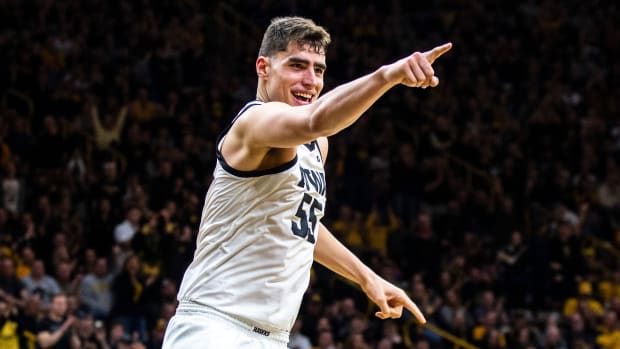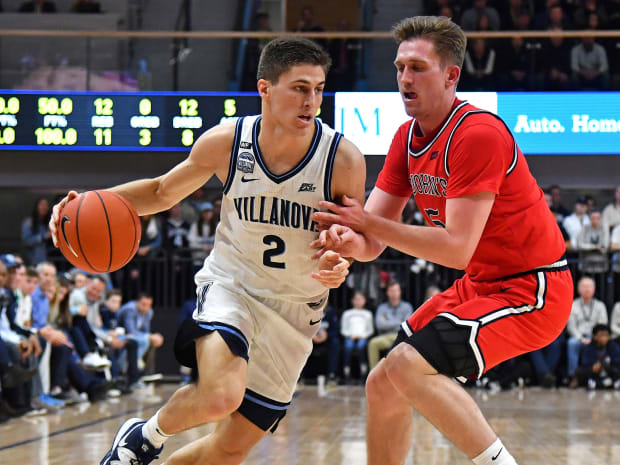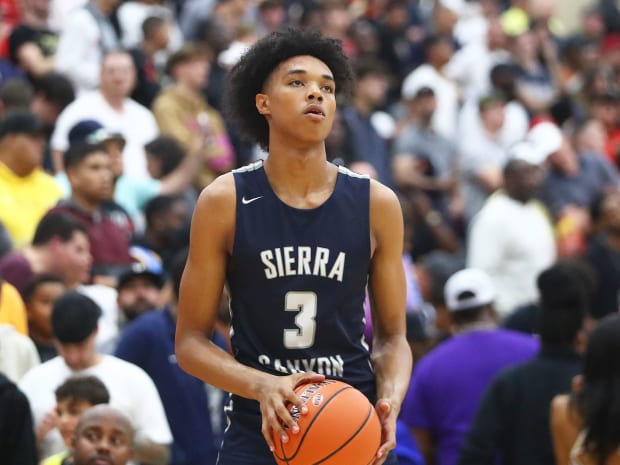Breaking down the case for and against 10 preseason contenders, from Luka Garza to Matthew Hurt.
Alright, we can’t put this off any longer—college basketball starts this week. This is shaping up to be the weirdest season in some time, factoring in the impact of COVID-19 on scheduling and availability, as well as the fact that there’s no clear-cut top team on paper. The hierarchy could look much different in a few weeks, and this list might look foolish as well. Just like there’s no truly obvious No. 1 team, there’s not one sole award candidate with an immense advantage in that conversation. But, knowing what we know at the moment, here are 10 players to keep in mind as potential contenders for top honors come March.

1. Luka Garza, Iowa – Senior
The case for: Garza was the centerpiece of one of the truly elite offenses in college basketball last season, winning numerous awards, including Big Ten Player of the Year, and earning consensus first team All-American honors. Garza averaged 23.9 points and 9.8 rebounds, scored efficiently inside and out, and put together a highly convincing statistical case. Factor in the departures of a majority of the talented bigs in his conference, as well as the potential for Iowa to improve, and there’s not really any reason Garza won’t do it again. He has the inside track in a wide-open race as the season gets underway.
The case against: Garza is a somewhat plodding defender, and Iowa’s shortcomings (they went just 20–11 last season despite a top-five offense) stem largely from their woes on that end. Can the Hawkeyes win the Big Ten without a major leap forward from their entire group? Is a top 50-caliber defense possible when Garza is on the floor nearly all the time? We’ll find out whether or not his weaknesses are inextricable from the struggles of the team. Then again, these awards are often handed out for production, and we can count on him for that much.
2. Cade Cunningham, Oklahoma State – Freshman
The case for: He has yet to step on the floor in a college game, but Cunningham very well might already be the best player in the country, with a remarkable winning pedigree and exceptional, mature approach to running his team. He would almost certainly have been the No. 1 pick in last week’s NBA draft, and has a strong chance to earn that mantle in 2021. Cunningham’s size, passing vision and commitment to winning, not personal stats, makes him a special pro prospect, and his unique ability to control gameflow and get the best out of his teammates will make a major difference for Oklahoma State. If the production is there at the end of the season, there may be no denying him top honors.
The case against: Cunningham is walking into the biggest test of his career: elevating a Cowboys lineup that isn’t particularly talent-laden or experienced. Mike Boynton will be meshing this group together for the first time, and they’ll be leaning hard on Cunningham to engineer wins and be a quick study. There’s no reason to think he won’t hold up his end of the bargain, but we’ve seen countless college teams driven primarily by star freshmen fall by the wayside, and there will be at least six tough opponents within the conference. Oklahoma State is also presently banned from postseason play. Finishing in the upper half of the conference could take a herculean effort from Cunningham, and as good as he is, that may not be enough to win voters over.
3. Jared Butler, Baylor – Junior
The case for: Butler returns as the best player on a Baylor team with national title aspirations, and he’s improved his numbers across the board each season. Butler’s toughness, leadership and productivity fit the mold here, and the potential for team success will surely enhance his candidacy. He was first team All-Big 12 and a third team All-American as a sophomore, and it’s hard to see him getting any worse. So if you’re making the best-player-on-best-team argument at the end of the year, Butler figures to be squarely in that conversation.
The case against: There are certainly flashier candidates on this list, and we shouldn’t assume Baylor simply rolls through a difficult conference that Kansas has dominated for a very, very long time. Losing big man Freddie Gillespie poses a major challenge for the Bears' defense, and their other standout big, Tristan Clark, retired from basketball due to debilitating knee injuries. Butler’s impact goes beyond his stat lines, and his numbers—particularly his assists—may not be as gaudy as some others by the end of the season, noting that Scott Drew will again employ a guard-heavy, multiple-ballhandler approach. There’s no question Butler is good enough, but circumstances could push him to the side a bit if the Bears don’t at least come close to last season’s 26–4 mark.

4. Collin Gillespie, Villanova – Senior
The case for: As history has shown, it’s always a great thing to be the point guard on a great Villanova team, and Gillespie and the Wildcats are unsurprisingly favored to win the Big East again. His individual game took a massive leap last season: Gillespie sharpened his playmaking skills, limited turnovers and discovered a new level of poise. The final step is making more consistent contributions as a scorer, and learning to do that without a pronounced physical advantage over defenses. Gillespie has a ton of opportunity as the Wildcats open the year as a top-five team in the polls.
The case against: We know Villanova runs Jay Wright’s offense effectively, and that it will be well-drilled to punch above its means. But glancing at the Wildcats' roster, there’s a pronounced lack of shot-creators, which shifts even more responsibility onto Gillespie to get the ball where it needs to go and elevate his teammates. Between Jeremiah Robinson-Earl, Justin Moore and Bryan Antoine, someone will need to raise their game. If there’s not enough all-around improvement from everyone else it’s hard to see Gillespie’s statistical case peaking. In short, there’s a little more margin for error here if the team underperforms, and his case likely depends on where Villanova finishes.
5. Marcus Zegarowski, Creighton – Junior
The case for: Zegarowski piloted the Bluejays’ top-five offense to a 24–7 mark last season and was basically their only capable playmaker. He shot north of 40% from three-point range in his first two seasons and upped his two-point mark to 53% last season, putting together a highly efficient season that elevated the performance of several teammates who otherwise struggled to create offense. If Creighton has a Big East title push in it, Zegarowski will end up with a strong case for All-American honors, and maybe more.
The case against: When opponents found a way to stop Zegarowski, things tended to go poorly for everyone else. Creighton replaces Ty-Shon Alexander with Duke transfer Alex O’Connell, but Zegarowski’s life as a high-usage guard isn’t getting any easier. Creighton was also not a great defensive team, and if Jacob Epperson and Ryan Kalkbrenner don’t provide immediate rim protection, a top 10-ish finish might be tricky, and that wouldn’t be great for Zegarowski’s standing in the national conversation.
6. Corey Kispert, Gonzaga – Senior
The case for: Well, someone from Gonzaga has to make this list, right? Kispert made 43% of his threes last season, was efficient from all over the floor, and stands as the Zags’ best player going into the season. He’s highly consistent, and a player defenses have to respect from deep, even if he doesn’t do much in the way of shot creation. With Filip Petrusev, Killian Tillie and Ryan Woolridge all gone, someone is going to have to pick up the slack. Kispert is their most experienced player, and should at least get a chance to be their star.
The case against: By the end of the season, Kispert may not even be the Zags’ best candidate for national honors. Junior Joel Ayayi or freshman Jalen Suggs will be tasked with creating more offense for others, and sophomore Drew Timme will pick up some slack up front. Gonzaga’s scoring could very well be more of a committee situation, where the production simply swings based on matchups or whoever’s hot on a given night. There’s too much talent on the roster to be completely sure how these roles are going to be distributed.
7. Ayo Dosunmu, Illinois – Junior
The case for: Dosunmu is the best player on an Illinois team with high expectations, and will play the lead role in its quest to reclaim the Big Ten. Although his three-point shooting regressed, he had an overall productive year as a sophomore, claiming a heavy share of the offensive workload on a team that held its own in conference play. The Illini bring back Kofi Cockburn up front and are expected to make a run at the conference title. If they take care of business, there’s a pretty good chance Dosunmu is responsible.
The case against: How good is Illinois really? It’s still fair to ask that question. They were a balanced team last year but not elite on either side of the ball. There’s no structural difference in the rotation beyond the additions of three freshmen—Adam Miller, Andre Curbelo and Coleman Hawkins—none of whom will be transformative on either side of the ball in Year 1. And unless Dosunmu’s jump shot takes a massive step forward, staying top 10 in the polls all year may be a challenge.

8. Brandon Boston Jr., Kentucky – Freshman
The case for: Boston is widely viewed as Kentucky’s top freshman, a sentiment I would agree with, and has a chance to lead them in scoring and be the best player on a potential SEC title winner. If he lives up to the considerable hype, there’s a clear pathway into the awards picture. Boston is a skilled scorer who will have some big nights, and if all breaks well should end as up one of the country’s better players. He’s a lottery-level NBA talent regardless.
The case against: The Wildcats have a ton of meshing to do, with a roster made up almost entirely of freshmen and transfers. It’s unclear exactly how shots will be distributed—it could be fellow freshman Terrence Clarke who ends up at the top of the pecking order—and the dynamic internally will be of great interest, and a determining factor in how good Kentucky can be. A lot has to go right here in addition to Boston proving he can be an efficient, go-to scorer on a good team.
9. Evan Mobley, USC – Freshman
The case for: Mobley’s sheer stat-padding potential puts him on the radar here—although he’s a freshman, his ability to block shots, rebound and score inside and out should make him an entertaining watch, and allow him to make a case as the best individual player in the Pac-12 immediately. He’s a flashier player than Onyeka Okongwu was, and if the Trojans can put together a better season, Mobley will benefit. His height, length and skill level are unique, and while we’re not talking Anthony Davis-level impact, it would be unwise to totally rule out a monster year.
The case against: First of all, we have no idea if USC will be that good (although if they are, it will be because of him). By my estimation, having watched him quite a bit in person, Mobley plateaued a bit last year in high school, and it would be a slight surprise to see him dominate at the level required to turn USC into a no-brainer tournament team. But the talent is certainly there.
10. Matthew Hurt, Duke – Sophomore
The case for: After a disappointing freshman year, Hurt is expected to be the guy for Duke, and if he delivers on the promise he showed in high school and the Blue Devils mesh quickly, he can be a factor. Hurt can be a key piece of Duke’s transition to a new team, which means remaining consistent enough to support multiple freshman in the lineup at all times. Reports out of Duke have been positive early, and Hurt is better positioned than fellow sophomore Wendell Moore to lead the team offensively. His percentage splits (57/39/74) are actually pretty good in hindsight, but his defensive struggles and lack of physicality on the interior made it hard for him to earn major minutes. Coach K will have to sink or swim with him this time around.
The case against: Again, there was a real reason Hurt only logged about half the available minutes for Duke last year, and there were games where he looked downright bad. For him to gain a better foothold, he has to prove that was a legitimate learning experience, and not an indicator of any lack of ability. As a former McDonald’s All-American, there’s obviously some potential for Hurt to break out. But until we see how much he’s improved, we can’t simply assume he’s going to make that leap. And there’s always a chance someone else on Duke—perhaps Moore or freshman Jalen Johnson—steps up as the team’s best player.
Honorable mention: Scottie Barnes, Florida State; Greg Brown, Texas; Marcus Garrett, Kansas; Sam Hauser, Virginia, Remy Martin, Arizona State